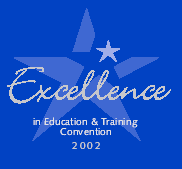
visit
to Singapore Polytechnic Alan
Dix
|
 |
|||
|
thanks |
slides
and notes |
|||
Excellence
in Education and Training Convention
keynote talks
|
PowerPoint
Slides (287K) |
TEACHING INNOVATION
In its mission statement, the Ministry of Education in Singapore says "Creative thinking skills and learning skills are essential for the future." However, creativity and innovation are often regarded either as inborn abilities or as uncontrolled inspiration. Neither view suggests creativity can be learnt. Furthermore, structured scientific and technological disciplines are seen as fundamentally different from 'creative' disciplines such as graphical design. In contrast, this session will demonstrate how combining divergent and structured thinking makes for effective innovation and that these skills can be taught, allowing the students' own creative potential to blossom.
|
PowerPoint
Slides (168K) |
INNOVATION IN TEACHING
Across the world, technological change is both enabling and challenging education. The traditional pattern of childhood schooling as preparation for working life gives way to lifelong learning supported by electronic delivery. How can education adapt? This session shows how the tools of innovation can be applied to education itself. Analysing particular educational experiences gives insights that can be reapplied in new situations, and deconstructing the traditional delivery methods of lectures, seminars and practicals can inspire repackaged e-Learning beyond simple emulation of the old.
small group talk, Wednesday 15th May 2002
|
PowerPoint
Slides (2Mb) |
IT IN EDUCATION : 2002 AND BEYOND
Reflection - Singapore now has one of the most extensive educational IT infrastructures in the world. One can clearly cite many groundbreaking uses of IT in the curriculum. Even with all these successes, one big challenge remains - how to make effective use of the advantages that the IT infrastructure has to offer to educators and students.
Changing Face of Technology - Back in the mid 90's, the dominant view of computing was the PC. At that time, the Internet was just beginning to surface as a universal network infrastructure. Now the global net has taken over as the dominant reason that many people adopt IT, and computing is also becoming more pervasive in the environment (mobile access, internet household appliances, wearable computers etc.) We need to carefully examine new advances in future technologies that will impact on "how and what" we should be teaching students in the use of IT, both at the workplace and home.
Challenges Lying Ahead - Internet commerce has forced companies to re-organise themselves and, at a personal level, people's models of community are changing. The world is being transformed by IT, and this in turn shapes the future course of IT and also the context within which we are educating our children. Singapore's educational objectives are as much about social and ethical foundations as they are about pure academic attainment. It is therefore essential that growing citizens understand the way IT is affecting their lives, their country and the world.
small group
talk, Thursday 16th May 2002
|
PowerPoint
Slides (570K) |
HCI FOR ON-LINE LEARNING
The talk was in two main parts, an overview of HCI and a top down analysis of e-learning.
In the overview of HCI we considered some examples of HCI issues including colour use and navigation guidelines. We also discussed the 'golden rule of design' - understand your materials - and how this applied to computers as a material with their special properties.
In the look at e-learning we looked at the key formula of educational economics and the costs of e-learning development. The slides also include further material that we didn't have time to cover in our session together..
SEE ALSO
My web pages on research and innovation
My May 2002 SIGCHI Bulletin column on Just-In-Time Theory
The mini-case studies used in my talks: Excel mode errors and a driving lesson.
BRIEF BIOGRAPHY
Education: D.Phil. (University of York) Dip. Mathematical Statistics (University of Cambridge) BA(Hons.) (University of Cambridge)
I have long hair, a beard and am the son of a carpenter. Thereafter all pretensions to saintliness end.
|
Notes HCI - human-computer
interaction Alvey - the Alvey programme was the UK government's response to the Japanese fifth generation computer programme in the mid 1980s. It was not as big in terms of money as the Japanese programme, but was significant in the UK both in kicking hi-tech research into high gear and also in making better industrial-academic links. |
I began as a bearded mathematician at Cambridge, worked as a research scientist at the National Institute of Agricultural Engineering (lots of brightly painted tractors), a Cobol programmer for Cumbria County Council (lots of beige and brown ICL mainframes), then in 1984, thanks to Alvey, I became a bearded computer scientist. I worked for almost 10 years at York University before moving to become a Reader at Huddersfield in 1994, where I lead the HCI Research centre hci@hud, and chaired the HCI95 conference. I was Associate Dean of the School of Computing at Staffordshire University for two years (lots of meetings) and am now a part-time Professor of Computing at Lancaster University. I have written and edited several books (see my web pages), including a big textbook on Human-Computer Interaction and a smaller textbook on Artificial Intelligence.
In general I'm interested in just about anything, especially the joints in wooden tables and why the stacking chairs in my office don't stack. I am married to Fiona with two daughters and two dogs.